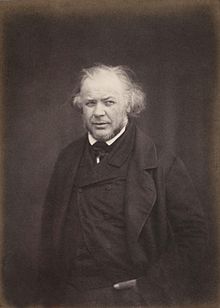Honoré Daumier
| Honoré Daumier | |
|---|---|

Honoré Daumier circa 1850.
|
|
| Born |
Honoré Victorin Daumier February 26, 1808 Marseille |
| Died | February 10, 1879 (aged 70) Valmondois |
| Nationality | French |
| Known for | Printmaking, Painting, Sculpture |
Honoré-Victorin Daumier (French: [ɔnɔʁe domje]; February 26, 1808 – February 10, 1879) was a French printmaker, caricaturist, painter, and sculptor, whose many works offer commentary on social and political life in France in the 19th century.
Daumier produced over 500 paintings, 4000 lithographs, 1000 wood engravings, 1000 drawings and 100 sculptures. A prolific draughtsman, he was perhaps best known for his caricatures of political figures and satires on the behavior of his countrymen, although posthumously the value of his painting has also been recognized.
Daumier was born in Marseille to Jean-Baptiste Louis Daumier and Cécile Catherine Philippe. His father Jean-Baptiste was a glazier whose literary aspirations led him to move to Paris in 1814, seeking to be published as a poet. In 1816 the young Daumier and his mother followed Jean-Baptiste to Paris. Daumier showed in his youth an irresistible inclination towards the artistic profession, which his father vainly tried to check by placing him first with a huissier, for whom he was employed as an errand boy, and later, with a bookseller. In 1822 he became protégé to Alexandre Lenoir, a friend of Daumier's father who was an artist and archaeologist. The following year Daumier entered the Académie Suisse. He also worked for a lithographer and publisher named Belliard, and made his first attempts at lithography.
Having mastered the techniques of lithography, Daumier began his artistic career by producing plates for music publishers, and illustrations for advertisements. This was followed by anonymous work for publishers, in which he emulated the style of Charlet and displayed considerable enthusiasm for the Napoleonic legend. After the revolution of 1830 he created art which expressed his political beliefs. Daumier was almost blind by 1873.
...
Wikipedia
